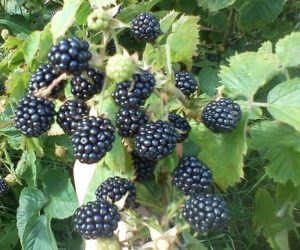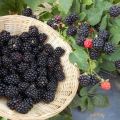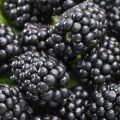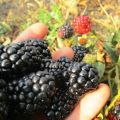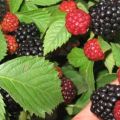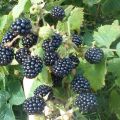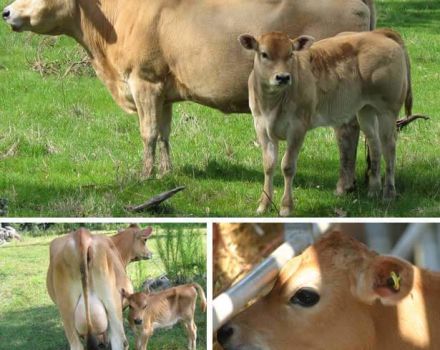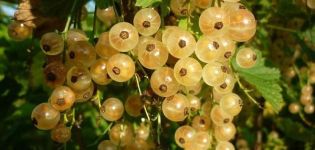Description and characteristics of Ruben blackberries, planting and care technology
Among the remontant blackberries, the Ruben variety gained its popularity not only for its ability to bear fruit several times per season, but for its large-fruited, relative unpretentiousness to the conditions of detention. Growing Ruben's blackberries in your summer cottage is available even to a novice gardener, the main thing is to know the basic subtleties of planting and care.
Breeding history
The bushy Reuben is the result of the efficient work of the renowned breeder, Professor John Ruben Clark. He conducted an experiment in 2005 and crossed the promising lines of the blackberry APF-44 and 2292T2. But this was only the first part of his work, then in 2006 he used the HPB3 seedling in an English nursery.
Ultimately, the bred Ruben blackberry successfully passed the test and appeared on the market in 2009. On the territory of Russia, the high-yielding variety was introduced in 2011-2012.
Description and characteristics of blackberries
The rebuildable blackberry Ruben is distinguished by its ability to form large fruits on the shoots of the current year. This plant belongs to the early maturing varieties. The height of its erect shoots is 170-200 centimeters, there is no need for support. The thorns of the Ruben blackberry are small, there are not so many of them, they do not create difficulties when harvesting.
The flowering phase of blackberries falls on the end of June (in the Moscow region). The flowers reach 5 centimeters in diameter and are white in color. The collection of the first fruits begins in early August, the fruiting period lasts until the onset of cold weather. The productivity indicators of blackberries are almost 6 kilograms per bush. The weight of the berries is within 10-16 grams, their size is about 4.4 centimeters.
For information! The tasting score of Ruben blackberry of 5 points is 4.5, and transportability is 4.7 points.
The fruits are distinguished by their rounded shape. They have a black color and a glossy surface. The consistency is quite dense and elastic. The fruiting plant has a high degree of frost resistance, up to -16 degrees. If Ruben blackberries are grown on the territory of the Central Lane, then you cannot do without additional shelter.
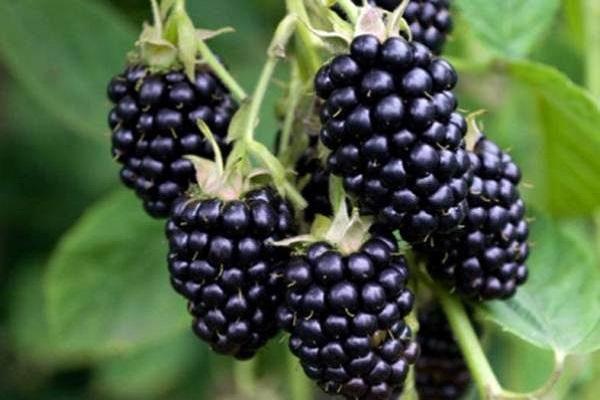
The main advantages and disadvantages of the variety
Experienced gardeners note among the positive characteristics of Ruben blackberries:
- renovation;
- not exactingness to care;
- there is no need for arranging supports, a garter;
- large-fruited;
- high taste of fruits;
- extended period of fruiting (from August to frost);
- high productivity of the bush;
- does not cause difficulties when sheltering for the winter.
But Ruben's blackberry also has its weaknesses, including:
- low level of drought resistance;
- insufficient winter hardiness;
- cannot stand excessive heat.

Features of growing blackberry Ruben
To achieve the desired result, it is necessary to carry out planting work in a timely manner and not neglect the simple rules of agricultural technology.
When is it better to plant
The optimal time for planting blackberry seedlings in the southern regions is autumn (late October). The main thing is to be in time 2-3 weeks before the onset of frost. But on the territory of the Central region, the Urals and Siberia, it is recommended to plant young plants in April, before the budding phase begins.
For information! If Ruben blackberry seedlings have a closed root system, then planting work can be carried out at any time.
How to choose and prepare a landing site
Remarkable is the fact that Ruben blackberries are capable of effectively producing crops in one place for 10-15 years. But this is subject to the correct location. Given that the variety does not tolerate heat well, it is better to define it in light partial shade. The site must be protected from cold winds by various outbuildings, structures, fences.
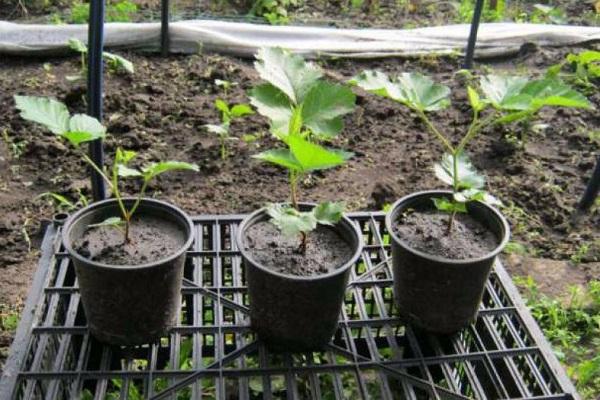
It is worth planting seedlings in the place where green manure, legumes, cereals and pumpkin crops grew before. It is not rational to place blackberries after strawberries and raspberries, since these plants suffer from the same fungal infections and rot. Also, do not choose damp or wetland areas.
Important! For Ruben blackberries, the best option is a soil with sufficient air and moisture permeability, a neutral (slightly acidic) environment.
To get large and tasty fruits from Ruben blackberries, it is necessary to add 500 grams of lime per 1 square meter to acidic soil, and 1 bucket of sand to loamy soil. If the soil is sandy, then 1 bucket of peat or decayed vegetation is used per 1 square meter.
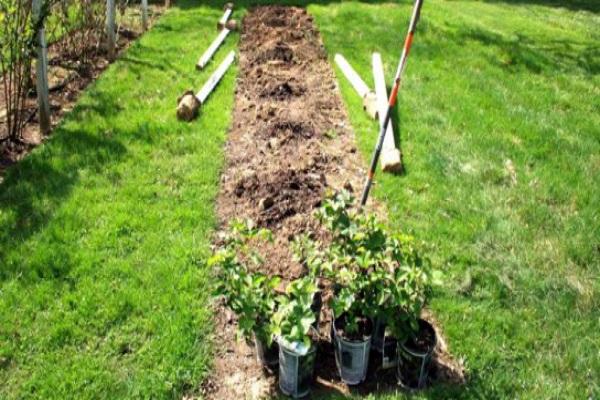
How to plant Ruben blackberries
First of all, you need to choose the planting material correctly. A quality seedling has 1-2 stems with a thickness of 5 millimeters. There are no suspicious foci, cracks, signs of disease on the bark. The underground part should consist of 2-3 roots from 10 centimeters long, and many small adventitious processes. For rapid rooting, the roots should be treated with a solution of Kornevin, heteroauxin, which is prepared according to the manufacturer's instructions.
If you plan to plant several bushes, then you need to maintain a distance of 100-130 centimeters between them. The distance between the rows should be 200 centimeters. The planting algorithm provides for the following actions:
- Free up space for planting from weeds.
- Add useful components to the soil at the rate of 10 kilograms of compost (humus), superphosphate (100 grams), potassium sulfate (30 grams) and wood ash (100 grams) per 1 square meter.
- After 2-3 weeks, form planting pits 45 centimeters deep.
- Lay expanded clay drainage at the bottom.
- Fill the hole with a fertile compound in the form of a mound.
- Place a seedling in the center, straighten its roots, deepening the lower buds by 2-3.
- Sprinkle with soil and compact it carefully.
- Water at the rate of 10 liters of water per planting.
- Fill to the top with dry earth.

At the end of planting work, the bush is mulched and shortened to a height of 15-20 centimeters. Thanks to this technique, it is possible to improve not only the quality of survival, but also the growth of lateral branches.
Specificity of crop care
Since the Ruben blackberry is a remontant plant, for its normal growth and development, you need to know some rules of care.
Watering
In this case, you should not overdo it with irrigation measures, there is a high probability of root rot. But the lack of moisture also adversely affects the blackberry - pollination worsens, the ovaries are poorly poured, and soon crumble. Irrigation should be done 1 time in 7 days, spending 10 liters of water per planting. It is more efficient to carry out the procedures in the evening, and transfer loosening to the morning.
To prevent moisture evaporation, the soil must be mulched. From the scorching sun, the bushes should be shaded with a net, which will also increase the pollination rates. At temperatures from +30 degrees, pollen becomes sterile. Watering is especially important during the blooming season.

Top dressing
When planting, a sufficient amount of nutrients is introduced into the hole, which is enough for the bush for 2 years. But on the third, it is already required to perform feeding procedures:
- in April, urea is used (3 tablespoons per 5 liters of water);
- in September-October, superphosphate (100 grams), potassium salt (30 grams) are used.
At the flowering stage, Ruben blackberries will benefit from feeding with wood ash at the rate of 100 grams per 10 liters of water. It is not worthwhile to apply nitrogen-containing fertilizers in the second half of summer, otherwise, with the intensive growth of green mass, the level of resistance to low temperatures will worsen.
For information! Boric acid, used during the flowering stage, improves the quality of fruit set.
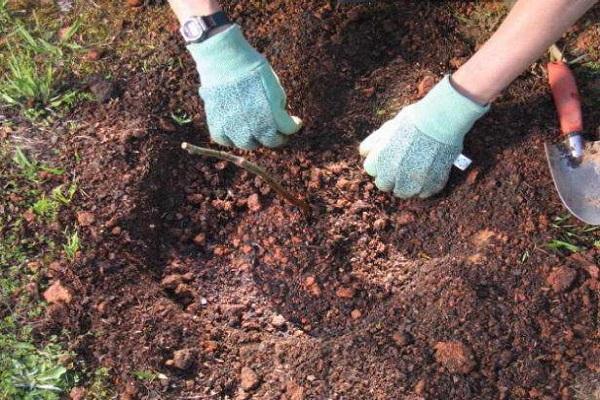
Pruning and preparing for winter
Complete removal of all shoots is carried out in November. This makes it possible to both rejuvenate the bush and increase frost resistance. Before winter, the root zone is protected with mulch. The cut branches are disposed of, burned.
Diseases and pests of the bush
One of the main advantages of Ruben blackberry is an increased immunity to diseases and parasitic species. Gray rot affects the berries below, only with excessive moisture. It is possible to save the crop by spraying the plant with Bordeaux liquid 1% (at the beginning and at the end of the flowering stage).
If the summer is dry, then the blackberry can be attacked by colonies of small aphids. This pest feeds on plant sap and destroys it. Since the carriers of this misfortune are ants, it is necessary to fight with them. The most suitable for these purposes Anteater, Cypermethrin. The affected shoots are cut off, and the bush is sprayed with Aktara's solution (2 grams per 10 liters of water) before and after the flowering phase or Aktellik (2 milliliters per 2 liters of liquid).

Breeding methods
To breed Ruben blackberry effectively in several ways:
- Layers. They are dropped into pre-fertilized pits near the mother bush, fixed with staples. After the formation of their own roots, they are separated.
- Seeds. The method works, but the fruits can only be harvested in the third year.
- Cuttings. In the middle of summer, green cuttings are divided into fragments 10 centimeters long, seated in separate containers, moistened as the top layer of the soil dries, and covered with a mini-greenhouse. Regular airing and watering are carried out. Determined to a permanent place after 1 month.
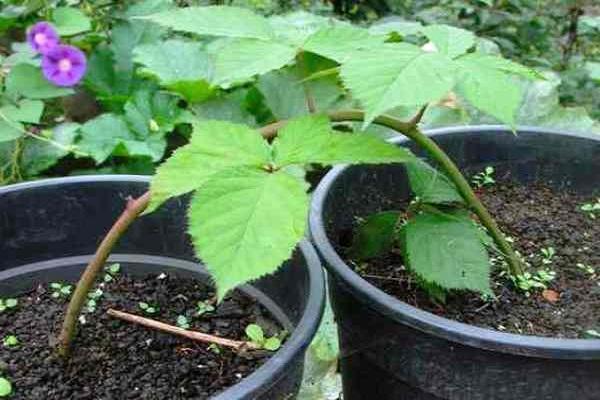
Harvesting and storage
Blackberry Ruben is a plant with an early ripening period, so the first harvest can already be taken in the last days of June, and the next one - in September-November. The fruits should be plucked together with the stalk, but it is better to cut them off so that they are stored longer. The shelf life of Ruben blackberries at room temperature is 4 days, in the refrigerator - almost 3 weeks.
Blackberry Ruben rightfully belongs to the promising varieties. It is unpretentious and produces large berries. It is enough to adhere to the correct agricultural techniques in order to collect a rich harvest.
